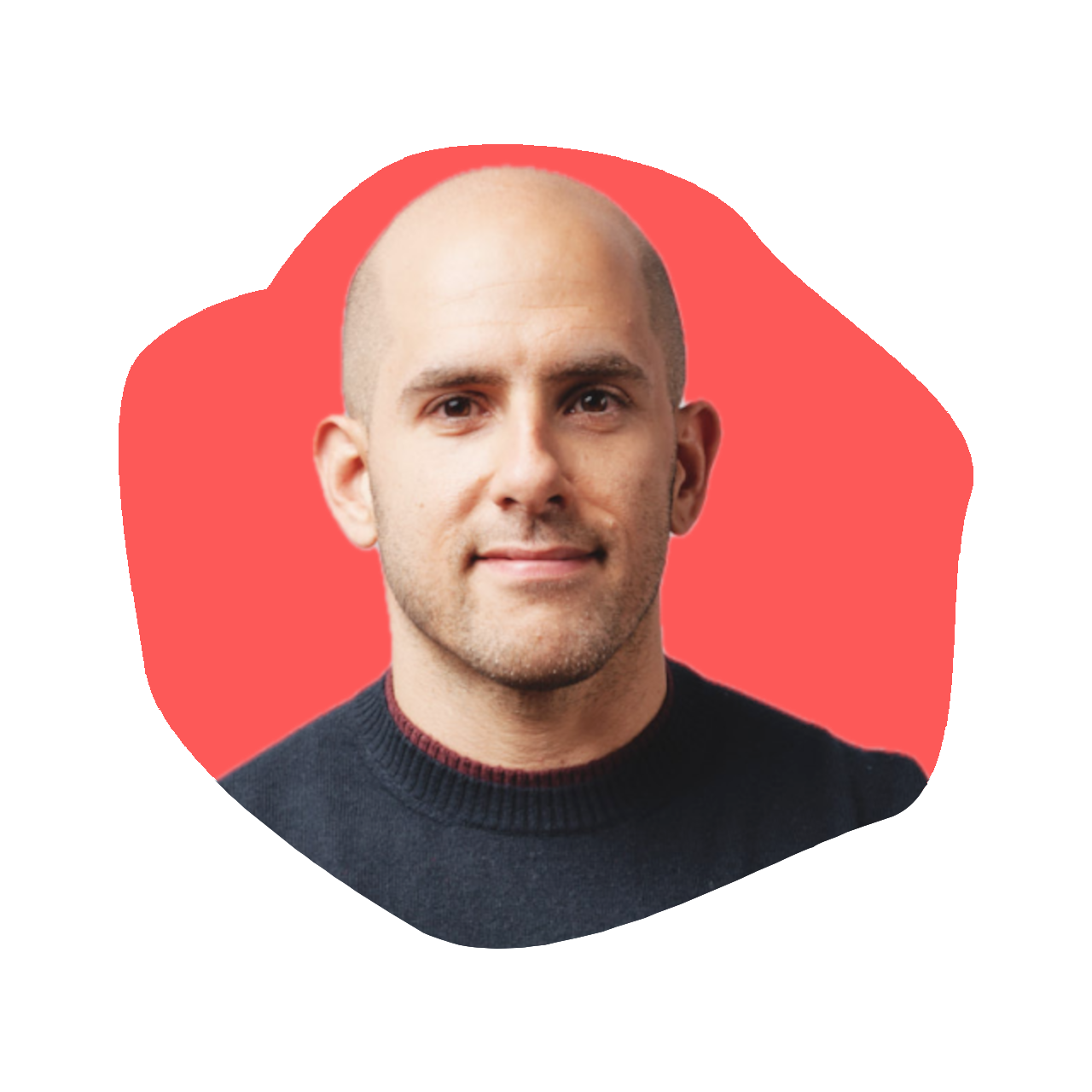Martin Reeves: Author of LIKE: The Button That Changed the World
Episode 712

Hi everyone, and welcome back to The Kara Goldin Show! Today’s guest is someone who literally wrote the book on how one tiny-ass button changed the whole damn world. I’m joined by Martin Reeves, Chairman of the BCG Henderson Institute and co-author of LIKE: The Button That Changed the World.
You’ve tapped it. You’ve chased it. You’ve felt the dopamine hit. But what’s the real story behind the “like” button? In this episode, Martin and I dive deep into the origins of the iconic thumbs-up, how it became the foundation of today’s attention economy, and the unexpected ripple effects it’s had on business, mental health, and even artificial intelligence. We talk about how this seemingly simple feature changed the way we measure validation, shaped entire industries, and taught us what not to overlook when launching innovation in a tech-saturated world.
If you’re curious about the intersection of psychology, business, and technology—and how small signals can drive massive behavior—you won’t want to miss this one. Now on The Kara Goldin Show.
Resources from
this episode:
Enjoying this episode of #TheKaraGoldinShow? Let Kara know by clicking on the links below and sending her a quick shout-out on social!
Follow Kara on LinkedIn – Instagram – X – Facebook – TikTok – YouTube – Threads
Have a question for Kara about one of our episodes? Reach out to Kara directly at [email protected]
To learn more about Martin Reeves and LIKE: The Button That Changed the World:
https://www.instagram.com/bcg/
https://www.linkedin.com/in/martin-reeves/
https://www.linkedin.com/company/bcg-henderson-institute/
https://www.linkedin.com/company/boston-consulting-group/
Transcript
Kara Goldin 0:00
I am unwilling to give up that I will start over from scratch as many times as it takes to get where I want to be. I want to be you. Just want to make sure you will get knocked down. But just make sure you don’t get knocked out, knocked out. So your only choice should be go focus on what you can control. Control. Control. Hi everyone, and welcome to the Kara Goldin show. Join me each week for inspiring conversations with some of the world’s greatest leaders. We’ll talk with founders, entrepreneurs, CEOs and really, some of the most interesting people of our time. Can’t wait to get started. Let’s go. Let’s go. Hi everyone, and welcome back to the Kara Goldin show. So excited for our next guest. Today’s guest is someone who literally wrote the book on how one tiny, tiny button changed the whole world. And I’m talking about Martin Reeves, who was also chairman of the BCG Henderson Institute, but he is the co author of an incredible book that I absolutely was not only really enjoyed, but also just made me keep thinking. And it’s one of these that I kept going back a few pages and then going forward, just to make sure that I understood exactly what he was saying about it, but the book is called LIKE the button that changed the world, and he’s tapped into it. He’s chased it. You’ve chased it, and you’ve probably felt the dopamine hit that comes from hitting this LIKE button and receiving LIKEs, I should also say, but what a story behind this LIKE button? And that’s exactly what he and his co author, Bob Goodson have jumped into so well you will get into the psychology that makes it so addictive, and the ripple effects it’s had on mental health business and AI innovation, of course. So stay tuned. And Martin, without further ado, welcome to the show.
Martin Reeves 2:07
Thanks very much. Kara, glad to be here. Let’s start with
Kara Goldin 2:12
the title, LIKE the button that changed the world. What is the story behind this button? In a few short sentences, I guess. And what made you so interested in writing this book?
Martin Reeves 2:26
Well, I bumped into the story by bumping into Bob Goodson, who is the founder of quid, a Silicon Valley analytics company. He was also employee number one at Yelp, and I discovered that he was one of the people who’s involved in the design, the invention of the LIKE button, and it’s just such a fascinating story about something that so small, that had such an enormous impact that we haven’t thought about very much eyes. I was really interested in how these, this dozen lines of JavaScript code with a thumbs up symbol attached the LIKE button, could have such a profound impact, and it took us into evolutionary biology. It took us into brain science. It took us into social psychology. It took us into web 2.0 and coding and artificial intelligence and many other things too. So I, I love the breadth of the story that this little LIKE button showed to us.
Kara Goldin 3:25
So you just literally ran into this you it wasn’t a thought that you had been thinking for years and years, but you were very intrigued after you had spoken with Bob about this topic.
Martin Reeves 3:39
Well, I was primed to tune into this story by two things. I think one of them is, I do a lot of work on innovation, and my research and innovation suggests that innovation is rarely the neat heroes story that we often think of it as being one person great foresight, solving a very clearly a defined problem in a short space of time. It’s it’s usually much more messy than that. So when I stumbled across the messiness of the of the LIKE button that was that was attractive, and I was tuned into that. The other thing is that for a book I wrote on the role of the imagination in imagination, in sorry, an innovation called the imagination machine. One of the things I did with that book was to create an online art gallery of the drawings of the inventions that changed the world, the first drawings of inventors. And when Bob showed me his sketch from 2005 I thought, that needs to go in the imagination gallery. And there the conversation started.
Kara Goldin 4:42
So let’s backtrack a bit. What is your day job, I guess, beyond writing this incredible book.
Martin Reeves 4:50
So So I lead something called the Henderson Institute, which is BCG think tank on new ideas and strategy and management. So I. Look at everything from, you know, innovation theory through to, you know, AI strategies, new ways of organizing. But the the particular theme here is one of great personal interest, which is, how does innovation really work?
Kara Goldin 5:15
Definitely. So What year was this that the LIKE button actually came to be?
Martin Reeves 5:23
Well, that sounds LIKE a simple question, and that was indeed the first question that Bob and I attacked, which is, who invented the LIKE button? So Bob showed me a sketch, essentially a dated sketch that he had made in 2005 and that date immediately struck me as being way in advance of what I thought the LIKE button was all about, which is Facebook’s propagation of the LIKE button in in 2009 so my first question to Bob was, Are you telling me you invented the LIKE button? Bob? And he said, Well, of course not. Maybe I’m not sure, and I thought that was such a strange response that our 30 minute first coffee conversation turned into a 12 hour conversation, at the end of which we had sort of the outline for a book. But the prime question was, who invented the LIKE button? And well, that’s really the story of how innovation really works. It’s social. Many people are facing the same things, the same problems, at the same time. And if you look closely enough, most inventions don’t have a single inventor. That’s certainly the case for the LIKE button. So we could say that the the, you know, the early mankind invented the the LIKE button in the sense that the thumbs up gesture is 1000s of of years years old. And we could say that that the early bulletin boards of the remember digital bulletin boards of the ninth, early 1990s they had a voting function. It wasn’t a LIKE button, but it was a first step towards the LIKE button we have in the late 90s. We have the little buttons on the TiVo handset. If you remember, it was impossible for even PhD engineers to program their their video recorders and TiVos. Response to that was to have a little thumbs up, a little thumbs down, physical button on the handset. But if you pressed it, it remembered what you LIKEd. But it wasn’t a fully digital button, perhaps. So you’ll remember, in our youth, there was a site called Hot or Not, where you voted on the appearance of your of your friends. Were they hot or not? And this was, this was quite an innovation, because in the in the early 2000s we didn’t have broadband. Very few people had in a broadband networks. So the last thing you wanted to do, if you were interacting with users was to trigger a page refresh, because you might lose them for 20 or 30 seconds. So hot or not, was a site which invented one click digital voting without triggering a page refresh. Or maybe it’s Bob and employee number one at Yelp, or 30 other sites that we, we list in the in the in the in the appendix to the book. So I think that all of these people had a role in the evolution of the LIKE button. And in fact, we, we devote the book to the tinkerers and makers who will, many of whom will be certainly forgotten by history. It’s a very innovation. Is more social than we than we often tell the story.
Kara Goldin 8:26
It’s so true. I was early at America Online, and the when I was reading through your book, I thought, the You’ve Got Mail phenomenon was, in many ways, was just LIKE, LIKE, right? It was this dopamine. It’s LIKE, you opened up your computer and turned it on, and then all of a sudden you, you know, you wanted to get mail, right? And you would hear that message come to you.
Martin Reeves 8:54
That’s the third question we tried to address in the book. So the first question was, who invented the LIKE button? The second one is, what does it tell us about how innovation really works? The third question is, really, why do we LIKE to LIKE, you know, what’s the humanity behind the code? And we we LIKE, we LIKE surprise, we LIKE social connection. And really, one of the things we discovered, I’m a former biologist, and so I wanted to go into the biology of this and one of the things we discovered is that the superpower of mankind is social learning. In other words, we can learn things which are beneficial to our survival, not just by trying them, LIKE most animals, but by looking at somebody else doing them, or by by learning from someone, and in order to learn from others, we there are some behaviors that are hardwired into our chemistry, so one of them is homophily. Homophily means I choose to learn from people LIKE me. So that’s the deliciousness of the ambiguity of the word LIKE I LIKE your content. I LIKE you, but I am LIKE you. We LIKE to learn from others, because those learnings are LIKEly to be applicable to people LIKE me. And then the second behavior is mild hierarchy. So the the hierarchies of the animal kingdom are based upon violence or the threat of violence, and in the human hierarchies are often based on respect or popularity. In other words, we want to learn from people who other people learn from. And think of the counter on the LIKE button and the word LIKE and so really the this LIKE button, the reason it’s spread LIKE wildfire, and why we never needed a manual on the LIKE button, is that it plugged directly into our evolutionary psychology, which is hardwired in our brain chemistry, the dopamine. Hit we hit we get from being LIKEd is the same as the dopamine hit of liking, and that is exactly the same thing offline and online. And that’s an evolved, highly evolved behavior. It plugs directly into that, definitely.
Kara Goldin 10:56
So in the book, you talk about how the LIKE button created a new kind of economy. Can you chat with us about that a little bit?
Martin Reeves 11:07
Right? So the LIKE button solved a tactical problem, which is, how do you get people to contribute content in the web, 2.0 web 2.0 was that the social network was was all about getting user generated content and but there was no reason why it should become a multi billion dollar business. I mean, it was just, that’s the tactical problem. Why did it become a multi billion dollar business? Because it’s solved for the age old problem of advertising, which is the joke, the serious joke that 50% of my advertising is wasted. I’ll just never know which 50% Well, that was true throughout the history of advertising, but by having a very granular feedback on who LIKEd your content, who LIKEd the advertisement, and we that problem was substantially solved, so that that allowed for the possibility of the attention based economy, which is essentially giving you free services LIKE free email and social media access in exchange for you leaving a data trail which told advertisers something about you, and that was mediated By the LIKE button, this, this little signal when when tapped often enough, leads to an enormous amount of knowledge on who you are and and what you LIKE. And so that was the the evidence based value advertising proposition, which, which Facebook innovated. So Facebook’s innovation was not the LIKE button, per se. It was a business. It was a business model based on the LIKE button, and that became a multi billion dollar industry, and in the process, it blew up another billion, multi billion dollar industry, the advertising and marketing industry, and created in a zoo of new players. So the the research, the part of the research of the book where I felt LIKE I was walking on the surface of Mars was when I went around interviewing teenage Tiktok stars who had 10s of millions of followers, and made these short lip syncing and dancing videos, and often generated multi million dollars of annual income in the in The process. So you know that that is a new ecosystem which which didn’t exist in the early days of the LIKE button.
Kara Goldin 13:29
What do you think has been the most surprising aspect of the LIKE button?
Martin Reeves 13:34
Well, I think, I think, in a way, every aspect of it in that, you know, innovation is serendipitous. Often we try and solve one problem and we we accidentally solve another. So the the tactical problems that the that the early pioneers were trying to solve were things LIKE, how do you prioritize a feed? How do you vote without triggering a page refresh, but the problem they inadvertently solved was, how do you monetize social media? And nobody at the time was trying to do that. That was an accidental outcome, a serendipitous outcome of trying to do something else. And then once we solved that problem, we of course, also had serendipitous side effects. We had unanticipated side effects, and nobody foresaw the that this little LIKE button would also become associated inadvertently with teenage mental health, internet addiction, depression used to create misinformation that that subverted democratic elections and so on. We we couldn’t foresee the full benefits. So how could we foresee the side effects? So one of the later chapters is about another question, which is, how do you regulate without foresight? Innovation? We generally come. Can’t see the benefits or the DIS benefits. So how can we regulate? And we, we had some thoughts on how to do that, and and the importance of that, giving how rapidly these very intrusive technologies spread nowadays, and, and all of that, of course, could be extremely useful with respect to the AI revolution, which is which is underway.
Kara Goldin 15:22
Some of these companies that you mentioned definitely benefited, probably benefited before consumers actually knew what was going on. And if you look at more than anything, the research and kind of the harm that has been done by this dopamine effects? Is it equal on both sides, equal harm to equal benefit? Or where do you think the economics of this all met out?
Martin Reeves 15:52
Well, we didn’t want to judge. There were in a number of books that sort of have analyzed rather pessimistically social media for a couple of reasons. I mean, one, we wanted to understand and and we wanted to learn how innovation worked, how regulator innovation worked. We also wanted to be pragmatic, in the sense of, we wanted to come up with some ideas on what you could do about it, not merely to judge it. And so I think that there are harms. But when we, when we see the harms of a technology, and there are always side effects from any any technology, it takes a while for society to figure out what they are, because there are many putative things that could be wrong and and it takes the time to sort out, well, what’s attributable to social media, what’s attributable to large companies, what’s attributable to the particular business model, what’s attributable to the to love the LIKE button. It takes a while to figure out the science and the causality, and then you know what to what to do about it, and in this particular case, it’s quite hard to separate the technology from the humans, because we’re dealing with this piece of evolutionary psychology, because so the problems of the LIKE button are really problems that we’ve always had. So we’re sensitive to how popular we are, and we’re delighted if we’re popular, and we can become a little depressed if we’re not and that is that is hardwired into our evolutionary psychology. So what exactly are we criticizing? So I think I came to the view that, you know, that the the difference between liking in real life and liking digitally is actually not one of quality, it’s one of quantity, because it’s exactly the same brain mechanisms. The thing which is different is I can only meet if I try really hard. Maybe, you know, five people called Kara per day, and maybe, you know, maybe only two of them will disLIKE me. And so it’s all within a within a bound, bound by the it’s constrained by the physics of social interaction. But if I’m a teenager at a very formative stage of development, I can sit in my bedroom and I can not only have hundreds of interactions. I LIKE this, I am LIKEd with respect to this or that, but also I can receive a comparative judgment. I can see how relatively LIKEd or disLIKEd I am by others. And you know that can be, that can be very impactful. So I think that, I think that many eventually will move to maybe restrict access to minors of social media. And Australia has done that, and Texas is close to doing that. And this is one of the of all of the sort of putative harms. This is one of the ones that I think is clearest. It’s a at the stage of early teens, when we are learning how to interact with others, we’re developing social skills. That’s when we’re most sensitive. And for some reason, young girls are especially sensitive. Now that said, I wouldn’t want to go backwards and and rerun history without social media. It creates tremendous, tremendous benefits, and we often take the benefits for granted and and criticize the and criticize the harms. But in a way, the harms are the call for the next wave of of innovation. Definitely.
Kara Goldin 19:20
What do you think based on you talked about individuals and how that button has affected them? But what is the one thing that brands, I guess, have misunderstood about how these LIKEs actually are driving action? I
Martin Reeves 19:36
think there’s some subtleties about you know, do we have a LIKE button and a disLIKE button or, and do we always show the counter and, and who do we? How do we protect children and so on, and, and do we do it with regulation, or do we do it with family norms? So Jonathan Haidt has just written a book about proposing that essentially, we should. We should educate our children on, on how to use, how to use the internet property, using family norms, which are much more powerful. You know what parents tell them about what you can and can’t do, than than with sort of heavy handed regulation. So, so I think we’ve learned the subtleties. We’ve learned the science of this. You know, what exactly the harm is, how it works. Also, I think on the benefit side, I think initially the LIKE button was was specific to social media and things LIKE encouraging user content, but it actually spilled over into into shopping. You know, you can now LIKE the thing you shopped and the person or the company you bought it from. It’s spilled over into entertainment. You can, it’s going, it’s LIKE going back to the TiVo, the psychology of the TiVo controller. We can, we can teach the algorithms on sites LIKE Netflix what we LIKE and what we don’t LIKE, which simplifies our navigation problem. And then actually even B to be businesses things LIKE, you know, logistical services have now become much better at receiving feedback on all of the things that they do for their customers and what their customers LIKE and what they don’t LIKE. I was actually, I’ve just come back from a trip to Europe, and I even discovered that you have LIKE buttons in toilets that I came across you. Do you LIKE your bathroom experience? So it really is quite quite pervasive and and essentially, it’s a very simple idea that is permitted by Internet technology, which is just creating the possibility of very granular feedback, which aggregated, can do all sorts of jobs, prioritize content, to tell people what you LIKE, give feedback on the quality of a service. So I think the non social media companies have also learned how to use this tool.
Kara Goldin 21:53
Yeah, definitely. Well, it’s fascinating. I’ve also thought that the word LIKE has been almost homogenized and in a way, because it’s not that you necessarily LIKE those experiences, but it’s really about that you don’t. It’s not LIKE you hate it, right? It didn’t bother you so much. It was okay, right? So you end up saying, you know, if there’s only two options and you don’t completely disLIKE it, then, then you’re more LIKEly to either, I guess, not hit the button, or just LIKE it.
Martin Reeves 22:29
One of the strangest reactions I’ve gotten to the book is the book in itself, actually also has a life of its own, and, and, and it’s somewhat serendipitous. So I as the book has been finding its its market and and resonating with people, there are some surprises. So one thing I’m surprised by is that for for middle aged people, it’s very much connected with the word LIKE. So when when teenagers say it’s kind of LIKE, great, LIKE, you know, that sort of sloppy way of speaking from a middle aged perspective, you know, that invokes a lot of emotion for for a certain type of person. So a lot of people ask me, Is this connected with the misuse of the word LIKE, and then related to that? Some people get a little upset that what is going on is not necessarily restricted to liking so I can, I can click the internet. I can click the button, the LIKE button, meaning I LIKE the content, or I LIKE you. Or I can also click it to mean I want to pretend that I LIKE it because you’re my boss. Or it can mean I prefer not to have a conversation about this, so I’m just going to LIKE it and have a smooth transaction. I’m going to I’m going to avoid a troublesome conversation. It can mean I want to be, pretend to be a member of your tribe or a tribe, or it can mean I want to curry favor with you in a way that’s very cost, cost efficient for me, which is I’m going to give you 20 LIKEs, and then I’m going to ask you for a favor. And, you know, some people I’ve spoken to have see this as sort of illegitimate and untruthful, but the truth is that human being, human beings, will always play every game with great subtlety, all of the games they can with any word or symbol in language. That’s That’s who we are. We do all of these things, from, you know, deception to compliments to an everything in between and and I think always, always will.
Kara Goldin 24:30
Yeah, definitely. So the LIKE button holds lessons for innovation. I loved your thoughts on that. What do you think is one of the biggest ones that you see potential for.
Martin Reeves 24:44
Well, a couple of things, if we accept this view that we may have learned in school that sir Humphry Davy invented the miner safety lamp, which prevented methane explosions in mines in the industrial revolution, and this solved a problem. One and then he moved on to the next invention. And it was one person, the sort of the hero story version of innovation, not really true. Even in that particular case, you look very closely and you see that there are at least three people that invented something very similar at the same time, and they they all fought with each other for credit for that invention and and the and history forgot two of them, so we were left with this very simple story, this heroic story that we LIKE to tell. But that’s that’s not really how the LIKE button or any other major invention works. It’s usually a population of people, a number of people facing similar problems at the same time, making similar inventions, begging, stealing and borrowing, you know, standing on the shoulders of giants, you know, building on something else that somebody else invented, and looking for a, finding B, and with eventual impact. See, you know the what they were trying to do and what the and the eventual impact are not normally connected. So I think one thing is, if we accept that view of innovation, the messy, serendipitous and social view of innovation, how would you change your processes in your company, to innovate more more more effectively? I think you do a number of things right? You would take heed of what others are doing. You would be open to the possibility that the impact may not, may not be the one that you’re looking for. So you’d be open to to reframing. You might have allow the invention to evolve over time, and so on and so on. So I think that’s one big thing. I think a second thing is regulatory innovation. Every every invention has some unintended negative effects. And, you know, being alert for those not trying to predict them necessarily, because that’s that’s very hard, but being alert to them in the early stages and and innovating in how we regulate, I think the number of possibilities we discuss, we discuss in the book. And then I think in the realm of technology, where things move very fast nowadays, I think leveraging these lessons for the next big technology wave, AI, I think is a, there’s another, there’s another set of learnings, learnings there to be had, I think, LIKE in particular, upping the regulatory game, I think that innovators don’t have access to the to the data that they need to make the early determination about emerging side effects. So you can think about public observatories where they can obtain that data. Regulators don’t always have the technical training so that they can understand the side effects of the latest technology. We can do something about that. And we discussed that and a number of other similar ideas in the book.
Kara Goldin 27:52
Such an interesting, thought provoking book. And if you’re watching it on the video here, we have it right here. It’s, it’s terrific, Martin, you and Bob have done such a good job of explaining this. I can see why this took more than a year, three years, to actually get it out the door. Because it must have been. You must have just wanted to keep looking at different variations of of the problem, right? And the solution. And it’s exciting on one hand, but it’s also, you know, somewhat scary, right? What you’re sort of jumping into, what is the one thing that you hope research? Sorry, that you hope readers walk away thinking about when they’re reading LIKE maybe
Martin Reeves 28:44
this is a strange thing to say, but I hope that they are entertained, because I’ve written 13 business books, and many of them are quite serious and informational, and I believe that sort of useful in their own way. But with this particular book, The the quirks, the quirks in the serendipitous story of the LIKE button are actually the point and and also it’s a very enjoyable story. So I wrote this deliberately in narrative form. So so the idea of the book is that this little thing that you never thought of had an incredible impact, and to understand that import impact, you have to be entertained. You have to pay attention to a very winding story, a story that winds through different disciplines. And you won’t do that unless you’re entertained. So actually, the narrative is designed for entertained. And the readers will tell me, I think whether, whether it, whether it achieved its its purpose or not, but I, you know, I think it’s an interesting idea, learning, seeing, seeing the macrocosm in the microcosm, seeing, seeing how, some serious questions LIKE, How does innovation work? How does innovation, regulation of technology work through the lens of the particular and the the winding. Story of of one, one small thing,
Kara Goldin 30:02
definitely, everybody needs to grab a copy of LIKE. It’ll change the way you think about not just the LIKE button, but in technology. It made me think about what else is out there today, and it is very entertaining. And you guys did an awesome job of doing that, but also, I think it’s, it’s a very thoughtful approach and really talking about influence and change and everything that I think so many of us are very, very interested in. So if you loved this episode, hit, hit, subscribe. Hit, LIKE and drop a review and share it with someone who you believe would be interested in this as well. And thanks so much, Martin. Really appreciate you joining us here today. And thanks everyone for tuning in and definitely pick up a copy of this incredible book LIKE you will not be sorry. So thanks again. Thanks very much, Kara. Thanks again for listening to the Kara Goldin show. If you would please give us a review and feel free to share this podcast with others who would benefit and of course, feel free to subscribe so you don’t miss a single episode of our podcast. Just a reminder that I can be found on all platforms at Kara Goldin, I would love to hear from you too. So feel free to DM me, and if you want to hear more about my journey, I hope you will have a listen or pick up a copy of my Wall Street Journal, best selling book, undaunted, where I share more about my journey, including founding and building hint, we are here every Monday, Wednesday and Friday. Thanks for listening, and goodbye for now. You.









